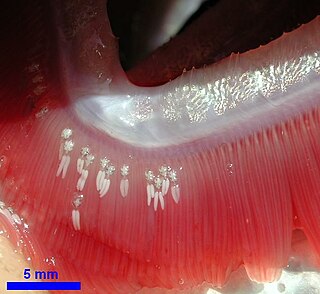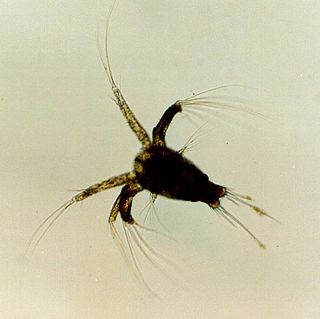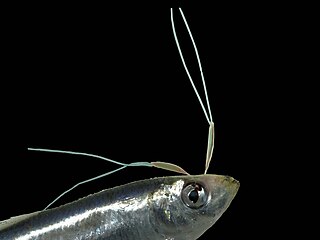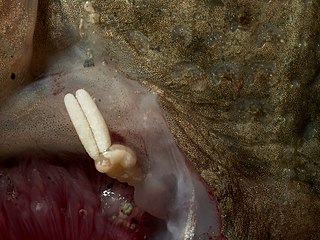
Copepods are a group of small crustaceans found in nearly every freshwater and saltwater habitat. Some species are planktonic, some are benthic, a number of species have parasitic phases, and some continental species may live in limnoterrestrial habitats and other wet terrestrial places, such as swamps, under leaf fall in wet forests, bogs, springs, ephemeral ponds, and puddles, damp moss, or water-filled recesses (phytotelmata) of plants such as bromeliads and pitcher plants. Many live underground in marine and freshwater caves, sinkholes, or stream beds. Copepods are sometimes used as biodiversity indicators.

Siphonostomatoida is an order of copepods, containing around 75% of all the copepods that parasitise fishes. Their success has been linked to their possession of siphon-like mandibles and of a "frontal filament" to aid attachment to their hosts. Most are marine, but a few live in fresh water. There are 39 recognised families:

Poecilostomatoida are an suborder of copepods. Although it was previously considered a separate order, recent research showed it to be nested within the Cyclopoida

Ergasilidae is a widespread family of copepods and comprises many species. The type genus is Ergasilus. With a few doubtful exceptions all ergasilids are parasitic on fishes.

Monstrilloida is an order of copepods with a cosmopolitan distribution in the world's oceans. The order contains a single family, Monstrillidae. The name of the first ever described genus Monstrilla is derived from latin, meaning "tiny monster", because the lack of usual diagnostic features of copepods puzzled early taxonomists.

The salmon louse is a species of copepod in the genus Lepeophtheirus. It is a sea louse, a parasite living mostly on salmon, particularly on Pacific and Atlantic salmon and sea trout, but is also sometimes found on the three-spined stickleback. It feeds on the mucus, skin and blood of the fish. Once detached, they can be blown by wind across the surface of the sea, like plankton. When they encounter a suitable marine fish host, they adhere themselves to the skin, fins, or gills of the fish, and feed on the mucus or skin. Sea lice only affect fish and are not harmful to humans.

Crustaceans may pass through a number of larval and immature stages between hatching from their eggs and reaching their adult form. Each of the stages is separated by a moult, in which the hard exoskeleton is shed to allow the animal to grow. The larvae of crustaceans often bear little resemblance to the adult, and there are still cases where it is not known what larvae will grow into what adults. This is especially true of crustaceans which live as benthic adults, more-so than where the larvae are planktonic, and thereby easily caught.

Pennellidae is a family of copepods, containing numerous genera, including:

Lernaeocera branchialis, sometimes called cod worm, is a parasite of marine fish, found mainly in the North Atlantic. It is a marine copepod which starts life as a small pelagic crustacean larva. It is among the largest of copepods, ranging in size from 2 to 3 millimetres when it matures as a copepodid larva to more than 40 mm as a sessile adult.
Nicothoë astaci or the 'lobster louse' is an ectoparasitic copepod that parasitises the gills of the European lobster species Homarus gammarus. The lobster louse was first reported in 1826 by Audoin & Milne-Edwards. N. astaci has been found on lobsters inhabiting locations including Scotland, Lundy Island in the Bristol Channel and as far south as France and Portugal. The louse possesses a narrow suctorial mouthpart to feed on host haemolymph. Internally, In its adult form, Nicothoe is barely mobile and most likely remains in the same position for most of its life. The parasite occurs in groups, particularly near the base of the gills, and study has gone into its effects on the lobsters, which are considerably important, commercially. Not much is known about its life cycle, since there are significant gaps in knowledge of certain stages of its growth.
Lernaeopodidae is a family of parasitic copepods. The females are typically large and fleshy, and attach to the host permanently using a plug made of chitin called the bulla. The males cling on to the females using their antennae. The family contains the following genera:
Pennella is a genus of large copepods which are common parasites of large pelagic fishes. They begin their life cycle as a series of free-swimming planktonic larvae. The females metamorphose into a parasitic stage when they attach to a host and enter into its skin. The males are free swimming. Due to their large size and mesoparasitic life history there have been a number of studies of Pennella, the members of which are among the largest of the parasitic Copepoda. All species are found as adults buried into the flesh of marine bony fish, except for a single species, Pennella balaenopterae which can be found in the muscles and blubber of cetaceans and occasionally other marine mammals, and is the largest species of copepod.

Lepeophtheirus pectoralis is a species of parasitic copepod from the northeast Atlantic Ocean, and the type species of the genus Lepeophtheirus. It is a parasite of flatfish, with the European flounder, the plaice, and the dab as the most frequent hosts. It feeds on the mucus, skin, and blood of the fish, with egg-producing females infecting the pectoral and pelvic fins of the host, while immature individuals and males are found on the rest of the body.

Clausidium dissimile is a species of copepod that has been found along the Atlantic and Gulf Coasts from Massachusetts to Florida. They are found on the bodies of mud shrimp of the family Callianassidae, or from water collected from mud shrimp burrows.
Peniculisa is a genus of marine parasitic copepods in the family Pennellidae.
Asterocheres lilljeborgi is a species of copepod in the family Asterocheridae. It is found in the British Isles and Scandinavia where it is a semi-parasite of starfish. First described as Asterocheres lilljeborgi in 1859 by the Norwegian marine biologist Jonas Axel Boeck, it is the type species of the genus.
Pennella exocoeti is a large ectoparasitic copepod, a specialist parasite of flying fish. The adult female copepod clings to the fish's gills or skin and feeds on its body fluids.

Lernaeenicus sprattae is a species of copepod in the family Pennellidae. It is a parasite of the European sprat and certain other fish and is sometimes known as the sprat eye-maggot.

Peniculus hokutae is a species of parasitic pennellid copepod. It has been described in 2018, from a single female. The type-host is the myctophid fish Symbolophorus evermanni and the type-locality is off Japan. The Japanese name of this species is hokuto-kozutsu-hijikimushi.

Acanthochondria cornuta is a species of parasitic copepod from the northeast Atlantic Ocean, and the type species of the genus Acanthochondria. It infects the gills of several species of flatfish, particularly the European flounder. Copepodids and immature females infect the holobranch of the host, while adult females prefer the pseudobranch and the internal wall, suggesting they migrate upstream in the gills of the host as they mature.











